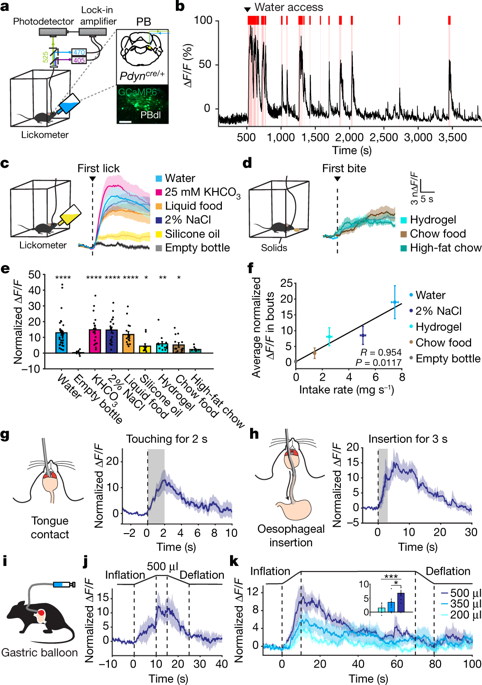Nature ( IF 64.8 ) Pub Date : 2020-04-08 , DOI: 10.1038/s41586-020-2167-2 Dong-Yoon Kim 1, 2 , Gyuryang Heo 1 , Minyoo Kim 1, 3 , Hyunseo Kim 1 , Ju Ae Jin 1 , Hyun-Kyung Kim 1, 3 , Sieun Jung 1, 2 , Myungmo An 1, 3 , Benjamin H Ahn 1, 3 , Jong Hwi Park 1 , Han-Eol Park 1 , Myungsun Lee 1, 3 , Jung Weon Lee 4 , Gary J Schwartz 5 , Sung-Yon Kim 1, 2, 3

|
Mechanosensory feedback from the digestive tract to the brain is critical for limiting excessive food and water intake, but the underlying gut–brain communication pathways and mechanisms remain poorly understood1,2,3,4,5,6,7,8,9,10,12. Here we show that, in mice, neurons in the parabrachial nucleus that express the prodynorphin gene (hereafter, PBPdyn neurons) monitor the intake of both fluids and solids, using mechanosensory signals that arise from the upper digestive tract. Most individual PBPdyn neurons are activated by ingestion as well as the stimulation of the mouth and stomach, which indicates the representation of integrated sensory signals across distinct parts of the digestive tract. PBPdyn neurons are anatomically connected to the digestive periphery via cranial and spinal pathways; we show that, among these pathways, the vagus nerve conveys stomach-distension signals to PBPdyn neurons. Upon receipt of these signals, these neurons produce aversive and sustained appetite-suppressing signals, which discourages the initiation of feeding and drinking (fully recapitulating the symptoms of gastric distension) in part via signalling to the paraventricular hypothalamus. By contrast, inhibiting the same population of PBPdyn neurons induces overconsumption only if a drive for ingestion exists, which confirms that these neurons mediate negative feedback signalling. Our findings reveal a neural mechanism that underlies the mechanosensory monitoring of ingestion and negative feedback control of intake behaviours upon distension of the digestive tract.
中文翻译:

一种用于摄取机械感觉反馈控制的神经回路机制
从消化道到大脑的机械感觉反馈对于限制过量的食物和水摄入至关重要,但潜在的肠-脑交流途径和机制仍然知之甚少1,2,3,4,5,6,7,8,9, 10,12。在这里,我们表明,在小鼠中,表达强啡肽原基因的臂旁核中的神经元(以下称为 PB Pdyn神经元)使用来自上消化道的机械感觉信号监测液体和固体的摄入。大多数个体 PB Pdyn神经元通过摄入以及对口腔和胃的刺激而被激活,这表明了消化道不同部分的综合感觉信号的表现。PB Pdyn神经元通过颅和脊髓通路在解剖学上与消化外围相连;我们表明,在这些通路中,迷走神经将胃胀信号传递给 PB Pdyn神经元。收到这些信号后,这些神经元会产生厌恶和持续的食欲抑制信号,这会阻止进食和饮水的开始(完全重现胃胀的症状),部分是通过向室旁下丘脑发出信号。相比之下,抑制相同群体的 PB Pdyn仅当存在摄取驱动力时,神经元才会诱导过度消耗,这证实了这些神经元介导负反馈信号。我们的研究结果揭示了一种神经机制,该机制是消化道扩张时摄入的机械感觉监测和摄入行为的负反馈控制的基础。


























 京公网安备 11010802027423号
京公网安备 11010802027423号